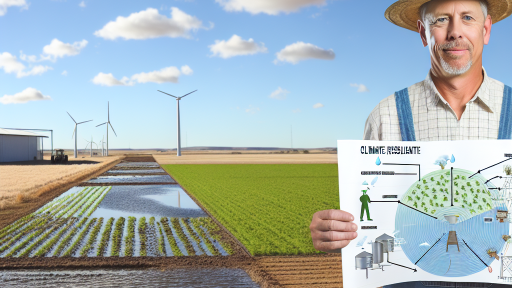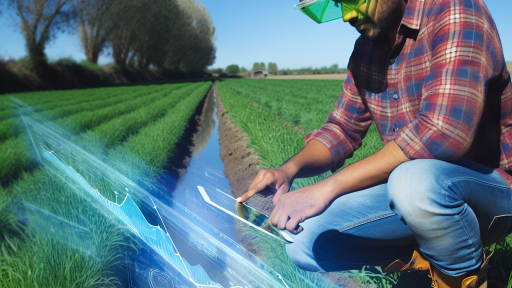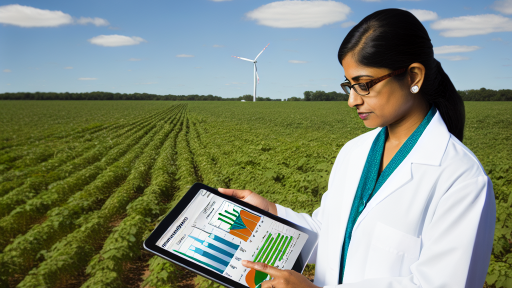Introduction to Carbon Sequestration and its Role in Agriculture
Understanding Carbon Sequestration
Carbon sequestration is the process of capturing and storing atmospheric carbon dioxide.
This technique reduces greenhouse gas concentrations in the atmosphere.
It plays a vital role in mitigating climate change effects.
In agriculture, carbon sequestration enhances soil health and productivity.
Benefits of Carbon Sequestration in Farming
This method offers multiple benefits to farmers and the environment.
- It improves soil structure and fertility.
- Carbon sequestration increases water retention in soils.
- This technique promotes biodiversity in agricultural ecosystems.
- It reduces the need for chemical fertilizers.
Methods of Carbon Sequestration
Farmers can implement several effective strategies to sequester carbon.
- Adopting cover crops improves soil organic matter.
- Practicing conservation tillage minimizes soil disturbance.
- Utilizing agroforestry enhances biomass and biodiversity.
- Implementing rotational grazing promotes healthy grasslands.
Each method contributes to a more sustainable agricultural system.
Challenges in Implementing Carbon Sequestration
Despite the benefits, farmers face challenges when adopting these practices.
Initial costs and changes in management can deter some producers.
Furthermore, education and awareness about these techniques are crucial.
Collaborative efforts and support will aid farmers in overcoming obstacles.
Future of Carbon Sequestration in Agriculture
The future of carbon sequestration looks promising for agriculture.
As technology advances, new methods will emerge for greater efficiency.
Research continues to enhance understanding of soil carbon dynamics.
Ultimately, widespread adoption can lead to resilient farming practices.
Transform Your Agribusiness
Unlock your farm's potential with expert advice tailored to your needs. Get actionable steps that drive real results.
Get StartedUnderstanding Soil Carbon Storage
The Basics of Soil Carbon Sequestration
SoiI carbon sequestration captures carbon dioxide from the atmosphere.
This process enhances soil health and fertility.
Carbon stored in soil improves nutrient availability.
Healthy soils support robust microbial communities.
Moreover, they increase water retention capabilities.
The Impact on Crop Yields
SoiI carbon storage directly influences crop yields.
Higher carbon levels lead to increased organic matter.
This organic matter enhances soil structure and aeration.
Consequently, it improves root development in plants.
Healthy roots absorb more nutrients and water.
Benefits Beyond the Farm
Increased productivity benefits farmers economically.
Higher yields can improve farm profitability significantly.
Additionally, sequestering carbon mitigates climate change effects.
This process contributes to global carbon reduction goals.
Farmers can play a crucial role in sustainability efforts.
Strategies for Enhancing Soil Carbon Storage
Implementing cover crops can boost soil organic carbon.
Cover crops prevent erosion and enhance soil health.
Reducing tillage retains more carbon in the soil.
Crop rotation diversifies plant types and enhances biodiversity.
Integrating livestock can add organic materials to soils.
Techniques for Implementing Carbon Sequestration on Farms
Exploring Cover Crops
Cover crops enhance soil health and capture carbon dioxide effectively.
These crops grow between main planting seasons.
Farmers can select species like clover, rye, or vetch.
Effective management of cover crops improves soil structure.
Showcase Your Farming Business
Publish your professional farming services profile on our blog for a one-time fee of $200 and reach a dedicated audience of farmers and agribusiness owners.
Publish Your ProfileThis practice also reduces erosion and nutrient runoff.
Adopting No-Till Farming
No-till farming minimizes soil disturbance significantly.
This technique preserves soil carbon and enhances its structure.
Farmers leave crop residues on the field for added nutrients.
Incorporating cover crops with no-till further enhances benefits.
This method requires careful planning and management.
Implementing Agroforestry
Agroforestry integrates trees into agricultural systems.
This method promotes biodiversity while sequestering carbon.
Farmers can plant trees along fields or incorporate them into pastures.
These arrangements can improve water retention and soil fertility.
Overall, agroforestry diversifies farm income and enhances resilience.
Utilizing Crop Rotation
Crop rotation enhances soil health and minimizes pest issues.
Farmers rotate different crops to retain nutrients and improve soil structure.
This technique naturally reduces reliance on chemical fertilizers.
The diversity of crops improves microbial activity in the soil.
Consequently, it enhances carbon storage capacity over time.
Applying Biochar
Biochar is a charcoal-like substance produced from organic materials.
Incorporating biochar into the soil enhances its carbon content.
This addition increases soil fertility and water retention.
Biochar also reduces greenhouse gas emissions from soil.
Farmers can produce biochar through controlled burning of biomass.
Enhancing Pasture Management
Improving pasture management boosts carbon sequestration in grasses.
Practices such as rotational grazing stimulate grass growth.
This increases the amount of organic matter in the soil.
Healthy pastures can store significant carbon for longer periods.
Thus, effective management practices lead to improved livestock health as well.
Integrating Sustainable Practices
Combining various sustainable farming practices can yield significant results.
Farmers should focus on tailored practices aligned with local conditions.
Collaboration among farmers can foster knowledge sharing and innovation.
Furthermore, educational programs can enhance awareness of these techniques.
A holistic approach to carbon sequestration benefits both farms and communities.
Discover More: Solar and Wind Technologies for Sustainable Farming
The Impact of Cover Crops on Carbon Sequestration and Farm Productivity
Understanding Cover Crops
Cover crops play a vital role in modern agriculture.
These plants grow during the off-season to protect and enrich the soil.
They prevent soil erosion and significantly improve soil health.
Farmers commonly use species such as clover and rye.
These crops efficiently capture carbon dioxide from the atmosphere.
Enhancing Soil Quality
Cover crops contribute to better soil structure.
They increase organic matter content, making soil healthier.
This improvement enhances water retention capabilities.
Showcase Your Farming Business
Publish your professional farming services profile on our blog for a one-time fee of $200 and reach a dedicated audience of farmers and agribusiness owners.
Publish Your ProfileHealthy soil supports robust plant growth and increases yields.
Boosting Farm Productivity
Using cover crops directly impacts farm productivity.
They can reduce the need for synthetic fertilizers.
Moreover, they suppress weeds naturally, saving costs on herbicides.
Farmers experience improved crop yields by adding cover crops to their rotations.
Increasing Carbon Sequestration
Cover crops play a crucial role in carbon sequestration.
They capture atmospheric carbon dioxide and store it in the soil.
This process mitigates climate change effects significantly.
Carbon-rich soil enhances microbial activity, further benefiting crops.
Long-Term Benefits of Cover Crops
The implementation of cover crops offers long-term advantages.
They promote biodiversity within agricultural ecosystems.
A diverse soil ecosystem improves resilience to pests and diseases.
Farmers observe sustained productivity over time with their use.
Practical Implementation
Farmers can begin integrating cover crops gradually.
Starting with small plots allows for observation and adjustment.
Choosing the right cover crop depends on specific farm conditions.
Considerations include local climate and soil type.
Consulting with agricultural experts can provide tailored guidance.
Discover More: Using Technology to Optimize Water Use on Farms
Agroforestry Practices that Enhance Carbon Sequestration
Introduction to Agroforestry
Agroforestry integrates trees and shrubs into agricultural landscapes.
This practice enhances both biodiversity and soil health.
Moreover, it increases carbon storage in the ecosystem.
Benefits of Carbon Sequestration
Carbon sequestration plays a vital role in mitigating climate change.
It captures and stores carbon dioxide from the atmosphere.
Additionally, it improves farm resilience against extreme weather.
Diverse Planting Strategies
Diverse planting enhances the carbon sequestration process.
Mixing tree species improves nutrient cycling and soil quality.
For example, planting nitrogen-fixing trees boosts soil fertility.
- Increases organic matter in the soil
- Enhances microbial activity
Reduced Soil Erosion
Trees and shrubs protect against soil erosion.
Their roots stabilize the soil structure effectively.
They also reduce runoff, promoting water retention.
Implementing Contour Planting
Contour planting involves planting along the landscape’s contours.
This strategy slows water runoff and captures more carbon.
It helps retain moisture in the soil during dry periods.
Intercropping Practices
Intercropping combines different crops in proximity for mutual benefit.
This practice can significantly boost carbon sequestration rates.
It also lowers pest pressure, enhancing overall crop yields.
Animal Integration into Agroforestry
Incorporating livestock into agroforestry systems offers multiple advantages.
Pigs can help clear land while enriching the soil with manure.
Chickens contribute through pest control and fertilizer production.
Showcase Your Farming Business
Publish your professional farming services profile on our blog for a one-time fee of $200 and reach a dedicated audience of farmers and agribusiness owners.
Publish Your ProfileMonitoring and Maintenance
Regular monitoring ensures the health of the agroforestry system.
Farmers can adapt their practices based on observed outcomes.
Maintenance is crucial for long-term success and carbon storage.
Find Out More: Carbon Footprint Reduction Methods for Farmers

Measuring the Benefits: How Carbon Sequestration Boosts Farm Profitability
Understanding Carbon Sequestration
Carbon sequestration captures and stores atmospheric carbon dioxide.
This process can significantly reduce greenhouse gas emissions.
It offers both environmental and economic advantages.
Impact on Soil Quality
Improved soil health leads to higher yields.
Carbon-rich soils retain moisture more effectively.
This can reduce irrigation costs for farmers.
Additionally, healthier soils enhance nutrient availability.
Cost Savings and Revenue Growth
Carbon sequestration practices reduce input costs over time.
Farmers can lower fertilizer and pesticide usage.
These savings directly impact overall profitability.
Moreover, better yields translate into increased sales revenue.
Access to Carbon Credit Markets
Participating in carbon credit markets presents new income opportunities.
Farmers can earn money by selling carbon credits.
This revenue can supplement traditional farming income.
Furthermore, securing additional funding can encourage sustainable practices.
Long-term Sustainability
Sustainable practices build resilience against climate change.
Farmers can maintain productivity even during adverse conditions.
This adaptability protects future profit margins.
By investing in carbon sequestration, farms become more sustainable.
Community and Economic Benefits
Increased farm productivity can boost local economies.
When farms thrive, they contribute to community well-being.
This economic growth can lead to job creation.
Additionally, local businesses benefit from increased agricultural activity.
Learn More: Advanced Mulching Techniques to Preserve Soil Moisture
Case Studies of Successful Carbon Sequestration in Farming
Carbon Sequestration in Regenerative Farming
Regenerative farming practices have gained traction globally.
This method increases soil organic matter and enhances carbon storage.
A notable example is Green Acres Farm in Oregon.
The owners, Clara and Tom, implemented cover cropping techniques.
They rotated crops to improve soil health and biodiversity.
As a result, their farm reduced carbon footprint significantly.
In the past five years, they increased soil carbon by 30 percent.
This improvement led to increased crop yields and reduced need for fertilizers.
Moreover, their profit margins have steadily increased.
Incorporation of Agroforestry Practices
Agroforestry integrates trees and shrubs into crop and livestock systems.
This approach enhances carbon sequestration effectively.
Briarwood Farms in North Carolina exemplifies this practice.
Showcase Your Farming Business
Publish your professional farming services profile on our blog for a one-time fee of $200 and reach a dedicated audience of farmers and agribusiness owners.
Publish Your ProfileThe farm adopted alley cropping with fruit and nut trees.
They created a diversified ecosystem that stored carbon efficiently.
Their land now sequesters an estimated five tons of carbon per year.
Additionally, the farm benefited from increased biodiversity.
It also improved soil structure, resulting in better water retention.
These changes contributed to healthier crops and livestock.
Success in Urban Agriculture
Urban agriculture can also effectively utilize carbon sequestration techniques.
A case in point is the Urban Harvest Cooperative in Seattle.
They transformed vacant lots into productive gardens.
By implementing composting and organic gardening practices, they enriched soil.
This action significantly enhanced their carbon storage capabilities.
Moreover, the cooperative educates local residents about sustainable practices.
As a result, the average carbon storage in their gardens increased by 25 percent.
Community engagement further amplified awareness about climate change.
This project showcases urban spaces’ potential for carbon sequestration.
Innovative Techniques in Dairy Farming
Some dairy farms are adopting innovative techniques for carbon sequestration.
A notable example is Sunny Pastures Dairy in Wisconsin.
The farm employed anaerobic digesters to turn waste into energy.
This process minimizes methane emissions and captures carbon dioxide.
Consequently, their overall carbon emissions decreased by 40 percent.
Additionally, they produce renewable energy for their operations.
This practice ensures a more sustainable approach to dairy farming.
Moreover, it positively impacts both the environment and their profitability.
Sunny Pastures is now a model for neighboring farms aiming for sustainability.
Future Trends in Carbon Sequestration and Sustainable Agriculture
Advancements in Techniques
Innovative methods continue to emerge in carbon sequestration.
Farmers are adopting cover cropping strategies to enhance soil quality.
These crops improve soil structure and reduce erosion.
Moreover, agroforestry practices combine agriculture with forestry effectively.
This approach boosts biodiversity while capturing atmospheric carbon.
Technological Integration
Technology plays a vital role in enhancing agricultural practices.
Precision farming tools optimize inputs and reduce waste.
Drones and sensors provide real-time data for better decision-making.
Artificial intelligence analyzes data to improve crop yields.
Emerging Policy Frameworks
Government policies are increasingly supporting sustainable practices.
Subsidies for carbon farming incentivize farmers to adopt eco-friendly methods.
Additionally, carbon credit markets reward effective sequestration efforts.
These frameworks encourage widespread implementation of sustainable techniques.
Public Awareness and Consumer Demand
Growing consumer awareness drives demand for sustainably produced food.
Many consumers prefer products with a lower environmental impact.
This shift influences farmers to adopt better practices.
Showcase Your Farming Business
Publish your professional farming services profile on our blog for a one-time fee of $200 and reach a dedicated audience of farmers and agribusiness owners.
Publish Your ProfileEducational campaigns highlight the importance of carbon sequestration.
Collaboration Across Sectors
Collaboration between farmers and researchers fosters innovation.
Partnerships with universities promote the development of best practices.
Moreover, private sector engagement supports funding for carbon projects.
These alliances enhance the effectiveness of sustainable agriculture efforts.
Additional Resources
NRCS Climate-Smart Mitigation Activities | Natural Resources …
How to Cut Emissions and Increase Food Production in the U.S. …




